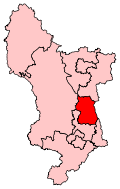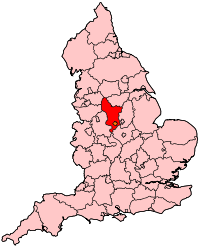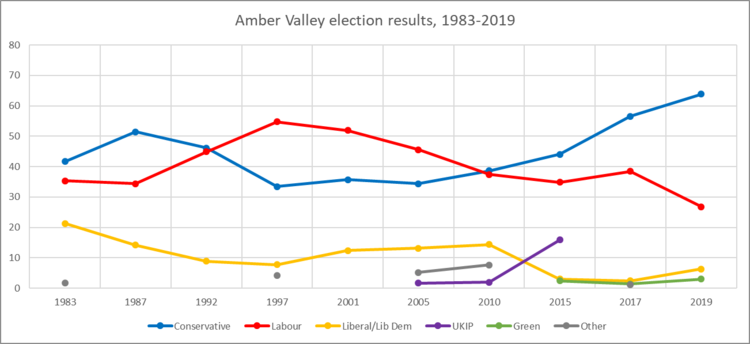Amber Valley (UK Parliament constituency)
Amber Valley is a constituency[n 1] in Derbyshire, represented in the House of Commons of the UK Parliament since 2010 by Nigel Mills, a Conservative.[n 2]
| Amber Valley | |
|---|---|
| County constituency for the House of Commons | |
 Boundary of Amber Valley in Derbyshire | |
 Location of Derbyshire within England | |
| County | Derbyshire |
| Population | 87,883 (2011 census)[1] |
| Electorate | 69,538 (December 2010)[2] |
| Major settlements | Ripley, Alfreton, Ambergate, Langley Mill |
| Current constituency | |
| Created | 1983 |
| Member of Parliament | Nigel Mills (Conservative) |
| Number of members | One |
| Created from | Belper, Derbyshire South East and Ilkeston[3] |
History
The constituency was created in 1983, and was held by Phillip Oppenheim of the Conservative Party from its creation until Judy Mallaber of the Labour Party won the seat in 1997. She was narrowly defeated in 2010 by Nigel Mills, a Conservative, who increased his majority in 2015 and 2017.[4]
Boundaries

1983–1997: The District of Amber Valley wards of Aldercar, Alfreton East, Alfreton West, Codnor, Denby and Horsley Woodhouse, Heage and Ambergate, Heanor and Loscoe, Heanor East, Heanor West, Holbrook and Horsley, Kilburn, Riddings, Ripley, Ripley and Marehay, Shipley Park, Somercotes, Swanwick, and Wingfield, and the Borough of Erewash wards of Breadsall and Morley, Little Eaton, and Stanley.
1997–2010: The Borough of Amber Valley wards of Aldercar, Alfreton East, Alfreton West, Codnor, Crich, Denby and Horsley Woodhouse, Heage and Ambergate, Heanor and Loscoe, Heanor East, Heanor West, Holbrook and Horsley, Kilburn, Riddings, Ripley, Ripley and Marehay, Shipley Park, Somercotes, Swanwick, and Wingfield, and the Borough of Erewash wards of Breadsall and Morley, Little Eaton, and Stanley.
2010–present: The Borough of Amber Valley wards of Alfreton, Codnor and Waingroves, Heage and Ambergate, Heanor and Loscoe, Heanor East, Heanor West, Ironville and Riddings, Kilburn, Denby and Holbrook, Langley Mill and Aldercar, Ripley, Ripley and Marehay, Shipley Park, Horsley and Horsley Woodhouse, Somercotes, Swanwick, and Wingfield.
Constituency profile
The Amber Valley constituency is located in the east of Derbyshire, and covers the market and manufacturing towns of Alfreton, Heanor and Ripley; in a majority of council elections from 1960 to 2012, these were favourably disposed to the Labour Party. The constituency also contains many rural and suburban wards, which during the same period generally had a majority in support of the Conservatives. The constituency stretches from the edge of the Peak District to the northern edge of Derby, which forms another set of neighbourhoods more favourably disposed to the Conservatives.
Since 2000 the Conservatives have controlled Amber Valley Borough Council with the exception of 2014-2015 and again in 2019 when Labour has been in power. Prior to this, the council was held by Labour or under no overall control for all but three years from its formation in 1973.
The constituency's generally small majorities in recent elections (an exception being the 2017 result) and bellwether status since 1983 (being won by the party that nationally holds the most parliamentary seats) means Amber Valley is, by most common measures, a marginal seat.
Members of Parliament
| Election | Member[5] | Party | |
|---|---|---|---|
| 1983 | Phillip Oppenheim | Conservative | |
| 1997 | Judy Mallaber | Labour | |
| 2010 | Nigel Mills | Conservative | |
Elections

Elections in the 2010s
| Party | Candidate | Votes | % | ± | |
|---|---|---|---|---|---|
| Conservative | Nigel Mills | 29,096 | 63.8 | +7.3 | |
| Labour | Adam Thompson | 12,210 | 26.8 | −11.6 | |
| Liberal Democrats | Kate Smith | 2,873 | 6.3 | +3.9 | |
| Green | Lian Pizzey | 1,388 | 3.0 | +1.6 | |
| Majority | 16,886 | 37.0 | +18.9 | ||
| Turnout | 45,556 | 65.1 | −2.3 | ||
| Conservative hold | Swing | +9.5 | |||
| Party | Candidate | Votes | % | ± | |
|---|---|---|---|---|---|
| Conservative | Nigel Mills | 25,905 | 56.5 | +12.6 | |
| Labour | James Dawson | 17,605 | 38.4 | +3.6 | |
| Liberal Democrats | Kate Smith | 1,100 | 2.4 | −0.6 | |
| Green | Matt McGuinness | 650 | 1.4 | −1.0 | |
| Independent | Daniel Bamford | 551 | 1.2 | N/A | |
| Majority | 8,300 | 18.1 | +8.9 | ||
| Turnout | 45,811 | 67.4 | +2.3 | ||
| Conservative hold | Swing | +4.5 | |||
| Party | Candidate | Votes | % | ± | |
|---|---|---|---|---|---|
| Conservative | Nigel Mills[10] | 20,106 | 44.0 | +5.4 | |
| Labour | Kevin Gillott[11] | 15,901 | 34.8 | −2.7 | |
| UKIP | Stuart Bent | 7,263 | 15.9 | +13.9 | |
| Liberal Democrats | Kate Smith | 1,360 | 3.0 | −11.5 | |
| Green | John Devine[12] | 1,087 | 2.4 | +2.4 | |
| Majority | 4,205 | 9.2 | +8.0 | ||
| Turnout | 45,717 | 65.1 | -0.4 | ||
| Conservative hold | Swing | +4.0 | |||
Going into the 2015 general election, this was the 24th most marginal constituency in Great Britain, Labour requiring a swing from the Conservatives of 0.6% to take the seat (based on the result of the 2010 general election).[13]
| Party | Candidate | Votes | % | ± | |
|---|---|---|---|---|---|
| Conservative | Nigel Mills | 17,746 | 38.6 | +4.7 | |
| Labour | Judy Mallaber | 17,210 | 37.4 | −9.0 | |
| Liberal Democrats | Tom Snowdon | 6,636 | 14.4 | +2.1 | |
| BNP | Michael Clarke | 3,195 | 7.0 | +4.4 | |
| UKIP | Sue Ransome | 906 | 2.0 | +0.3 | |
| Monster Raving Loony | Sam Thing | 265 | 0.6 | N/A | |
| Majority | 536 | 1.2 | N/A | ||
| Turnout | 45,958 | 65.5 | +1.5 | ||
| Conservative gain from Labour | Swing | +6.9 | |||
Elections in the 2000s
| Party | Candidate | Votes | % | ± | |
|---|---|---|---|---|---|
| Labour | Judy Mallaber | 21,593 | 45.6 | −6.3 | |
| Conservative | Gillian Shaw | 16,318 | 34.4 | −1.3 | |
| Liberal Democrats | Kate Smith | 6,225 | 13.1 | +0.7 | |
| BNP | Paul Snell | 1,243 | 2.6 | N/A | |
| Veritas | Alex Stevenson | 1,224 | 2.6 | N/A | |
| UKIP | Hugh Price | 788 | 1.7 | N/A | |
| Majority | 5,275 | 11.1 | −5.1 | ||
| Turnout | 47,391 | 62.9 | +2.6 | ||
| Labour hold | Swing | −3.8 | |||
| Party | Candidate | Votes | % | ± | |
|---|---|---|---|---|---|
| Labour | Judy Mallaber | 23,101 | 51.9 | −2.8 | |
| Conservative | Gillian Shaw | 15,874 | 35.7 | +2.2 | |
| Liberal Democrats | Kate Smith | 5,538 | 12.4 | +4.7 | |
| Majority | 7,227 | 16.2 | −5.1 | ||
| Turnout | 44,513 | 60.3 | −15.6 | ||
| Labour hold | Swing | −2.5 | |||
Elections in the 1990s
| Party | Candidate | Votes | % | ± | |
|---|---|---|---|---|---|
| Labour | Judy Mallaber | 29,943 | 54.7 | +10.3 | |
| Conservative | Phillip Oppenheim | 18,330 | 33.4 | −13.0 | |
| Liberal Democrats | Roger Shelley | 4,219 | 7.7 | −1.4 | |
| Referendum | Irene McGibbon | 2,283 | 4.2 | N/A | |
| Majority | 11,613 | 21.3 | N/A | ||
| Turnout | 54,775 | 76.0 | −8.7 | ||
| Labour gain from Conservative | Swing | 11.7 | |||
| Party | Candidate | Votes | % | ± | |
|---|---|---|---|---|---|
| Conservative | Phillip Oppenheim | 27,418 | 46.1 | −5.3 | |
| Labour | John Cooper | 26,706 | 44.9 | +10.6 | |
| Liberal Democrats | Graham Brocklebank | 5,294 | 8.9 | −5.3 | |
| Majority | 712 | 1.2 | −15.9 | ||
| Turnout | 59,418 | 84.7 | +3.5 | ||
| Conservative hold | Swing | −7.9 | |||
Elections in the 1980s
| Party | Candidate | Votes | % | ± | |
|---|---|---|---|---|---|
| Conservative | Phillip Oppenheim | 28,603 | 51.4 | +9.7 | |
| Labour | David Bookbinder | 19,103 | 34.4 | −0.9 | |
| Liberal | Stewart Reynolds | 7,904 | 14.2 | −7.1 | |
| Majority | 9,500 | 17.1 | +10.7 | ||
| Turnout | 68,478 | 81.2 | +4.0 | ||
| Conservative hold | Swing | +5.3 | |||
| Party | Candidate | Votes | % | ± | |
|---|---|---|---|---|---|
| Conservative | Phillip Oppenheim | 21,502 | 41.7 | N/A | |
| Labour | David Bookbinder | 18,184 | 35.3 | N/A | |
| Liberal | Brian Johnson | 10,989 | 21.3 | N/A | |
| Independent | Peter Griffiths | 856 | 1.7 | N/A | |
| Majority | 3,318 | 6.4 | N/A | ||
| Turnout | 66,720 | 77.2 | N/A | ||
| Conservative win (new seat) | |||||
See also
- List of Parliamentary constituencies in Derbyshire
- Opinion polling for the next United Kingdom general election in individual constituencies
Notes
- A county constituency (for the purposes of election expenses and type of returning officer)
- As with all constituencies, the constituency elects one Member of Parliament (MP) by the first past the post system of election at least every five years.
References
- "Usual Resident Population, 2011". Neighbourhood Statistics. Office for National Statistics. Archived from the original on 3 March 2016. Retrieved 25 January 2015.
- "Electorate Figures - Boundary Commission for England". 2011 Electorate Figures. Boundary Commission for England. 4 March 2011. Archived from the original on 6 November 2010. Retrieved 13 March 2011.
- "'Amber Valley', June 1983 up to May 1997". ElectionWeb Project. Cognitive Computing Limited. Retrieved 10 March 2016.
- "Majority Sorted Seats". electoralcalculus.co.uk.
- Leigh Rayment's Historical List of MPs – Constituencies beginning with "A" (part 1)
- "Amber Valley Parliamentary constituency". BBC News. BBC. Retrieved 20 November 2019.
- Bloom, Dan (7 June 2017). "Here is every single 2017 general election candidate in a plain text list". Daily Mirror. Trinity Mirror. Retrieved 7 June 2017.
- "Election Data 2015". Electoral Calculus. Archived from the original on 17 October 2015. Retrieved 17 October 2015.
- https://www.bbc.co.uk/news/politics/constituencies/E14000533
- "Political parties pick candidates in Amber Valley". Derby Telegraph. Archived from the original on 14 July 2014. Retrieved 18 June 2014.
- "The Labour Party". labour.org.uk. Archived from the original on 5 August 2013. Retrieved 9 November 2013.
- "General Election". Derbyshire Green Party. Archived from the original on 4 February 2015. Retrieved 26 January 2015.
- Ransome Mpini; Charlotte Thornton; John Walton; Marcelo Zanni (24 February 2014). "Election 2015: The political battleground". BBC News. Retrieved 29 January 2015.
- "Election Data 2010". Electoral Calculus. Archived from the original on 26 July 2013. Retrieved 17 October 2015.
- "Election Data 2005". Electoral Calculus. Archived from the original on 15 October 2011. Retrieved 18 October 2015.
- "Election Data 2001". Electoral Calculus. Archived from the original on 15 October 2011. Retrieved 18 October 2015.
- "Election Data 1997". Electoral Calculus. Archived from the original on 15 October 2011. Retrieved 18 October 2015.
- "Politics Resources". Election 1997. Politics Resources. 1 May 1997. Archived from the original on 12 August 2014. Retrieved 7 January 2011.
- C. Rallings & M. Thrasher, The Media Guide to the New Parliamentary Constituencies, p.142 (Plymouth: LGC Elections Centre, 1995)
- The 1997 election result is calculated relative to the notional, not the actual, 1992 result.
- "Election Data 1992". Electoral Calculus. Archived from the original on 15 October 2011. Retrieved 18 October 2015.
- "Politics Resources". Election 1992. Politics Resources. 9 April 1992. Archived from the original on 24 July 2011. Retrieved 6 December 2010.
- "Election Data 1987". Electoral Calculus. Archived from the original on 15 October 2011. Retrieved 18 October 2015.
- "Politics Resources". Election 1987. Politics Resources. 11 June 1987. Archived from the original on 22 May 2011. Retrieved 8 January 2011.
- "Election Data 1983". Electoral Calculus. Archived from the original on 15 October 2011. Retrieved 18 October 2015.
- "Politics Resources". Election 1983. Politics Resources. 9 June 1983. Archived from the original on 3 June 2016. Retrieved 8 January 2011.